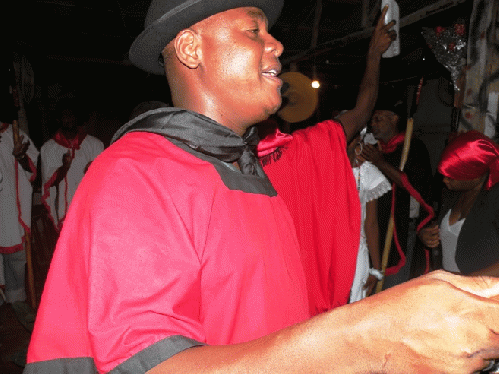********
Catch up on the investigative trip to Haiti by Georgianne Nienaber and myself from May 10 to May 13, 2010 by browsing these:
Click here for Part 1 of this series.
Click here for Part 2
Click here for Part 3
Click here for Part 4
Click here for Part 5
Click here for Part 6
Click here for Part 7
Click Here for Part 8
Click here for Part 9
Click here for Part 10
Click here for Part 11
Click here for Part 12
********
All this sucks the life-blood out of a people, these predatary, divisive, stratified institutions ruling through fear and violence, leaving the great majority of the body politic dispossessed and alienated from purposeful lives beyond mere day to day, desperate survival. And when you throw in a massive earthquake that traumatizes the entire nation, as happened on January 12, then truly your back is against the wall, and a people has to reach deep, very deep to find the strength to carry on. But what lies in the depths?
The answer to that can be found in the late 1700s of this island nation's history, when hundreds of thousands of African slaves toiled relentlessly, suffered hideously and died wretchedly under their ruthless French masters in what was then called Saint-Domingue, nick-named the Pearl of the Antilles, so-called because the wealth accrued from French sugar and coffee plantations had made it the richest slave-colony in the Caribbean, if not the world.
Inevitably, the extreme cruelty and violence of the French overlords was leading to revolution in Saint-Domingue, despite, or perhaps abetted by the French Crown's feeble, hypocritical efforts at establishing macabre, codified standards of treatment and punishment toward slaves in the late 1600s. Slave insurrections and escapes to freedom in the mountains became more and more frequent, and then with the great uprising from 1776 to 1783 of the victorious American Revolution unleashing shock waves throughout the Western Hemisphere and beyond, whispers of freedom and independence began echoing throughout the island's slave quarters.
What had been sustaining the hundreds of thousands of slaves heretofore, what they had been reaching into their depths of being for to find strength and perseverance against brutal oppression, were the powers of the spirit. These could only be clandestinely manifested through their ancestral African cultures and faiths as they had evolved in Saint-Domingue into what had become a new, syncretic form of African Vodou (Vodun, Vodoun), a form now combining forced elements of French Catholicism, an undertone of Amerindian Arawak (the original inhabitants of the island) influences and the traditional Vodou religion as practiced, in particular, in Guinea, Congo and Dahomey. The French had forbidden ancestral worship and rituals, because they knew there was human empowerment and resistance to oppression in that, so the slaves had had to disguise their thirst for the comforts of their own gods via Catholic trappings.
Then came a pivotal moment in Haitian history: Bois Caà �man. But before I say anything about that, let me explain that Haitian Vodou, not unlike Catholicism, believes in a Supreme Being, called Bondye (Bon Dieu - Good God), who, having created the Universe, then leaves the actual interactions with humanity to a lower order of divine beings called loa, of which there are many and varied. Worshipers pray to and petition the loa just like Catholics pray to the saints for guidance, favors or deliverance. And because African slaves had to hide their intentions from their masters or risk punishment, the saints did double duty, representing not only Catholic spirituality but the hidden loa they came to be associated with, such as with St. Peter of the Cross and Papa Legba, the Loa of the Crossroads.
But what, historically is Bois Caà �man? It is the traditional, revered site of a ceremony presided over by the Vodou priest (or Houngan) Dutty Boukman on August 14, 1791. Wikipedia has a concise explanation of what happened there:
According to the official "History of Haiti and the
Haitian Revolution"[2], in 1791 the following events occurred:
A man named Boukman, another houngan, organized on August 14, 1791, a meeting with the slaves in the mountains of the North. This meeting took the form of a Voodoo ceremony in the Bois Caiman in the northern mountains of the island. It was raining and the sky was raging with clouds; the slaves then started confessing their resentment of their condition. A woman started dancing languorously in the crowd, taken by the spirits of the loas. With a knife in her hand, she cut the throat of a pig and distributed the blood to all the participants of the meeting who swore to kill all the whites on the island. On August 22, 1791, the blacks of the North entered into a rebellion, killing all the whites they met and setting the plantations of the colony on fire. However, the French quickly captured the leader of the slaves, Boukman, and beheaded him, bringing the rebellion under control.
The following paragraph then goes on to say:
The death of
Boukman although it had temporarily stopped the rebellion of the North failed
to restrain the rest of the blacks from revolting against their condition. The
Revolution that would give birth to the Republic of Haiti
was under way and nothing could stop it. (source)
Thus a Vodou ceremony in 1791, as tradition tells it, served as the spark that set what would soon permanently be called Haiti on fire, culminating in the declaration of independence of Haiti from France on January 1st, 1804, despite the efforts of even Napoleon Bonaparte to maintain colonial control.
(Note: You can view every article as one long page if you sign up as an Advocate Member, or higher).





